Marketing Research Essentials: Myer Brand Awareness Impact Report
VerifiedAdded on 2020/02/24
|13
|2758
|75
Report
AI Summary
This marketing research report investigates the influence of Myer's brand awareness on consumer buying behavior in Australia. The research begins with an introduction outlining the research background, aims, objectives, and questions. A comprehensive literature review examines brand awareness, consumer buying behavior, and a conceptual framework. The methodology section details the deductive research approach, descriptive research design, non-probability sampling technique, and a sample size of 200 participants (150 quantitative and 50 qualitative). Data collection methods include primary data from surveys and interviews, and secondary data from various sources. Data analysis utilizes the SPSS tool and the Likert scale. The report acknowledges limitations such as potential language barriers and time constraints. A timeline outlines the research stages, from topic selection to final submission. The conclusion summarizes the research's aim to determine the effectiveness of brand awareness in influencing consumer buying behaviors, covering key aspects of brand awareness and its impact. The report provides valuable insights into Myer's marketing strategies and their effects on consumer purchasing decisions, offering recommendations for enhancing brand awareness and increasing sales.
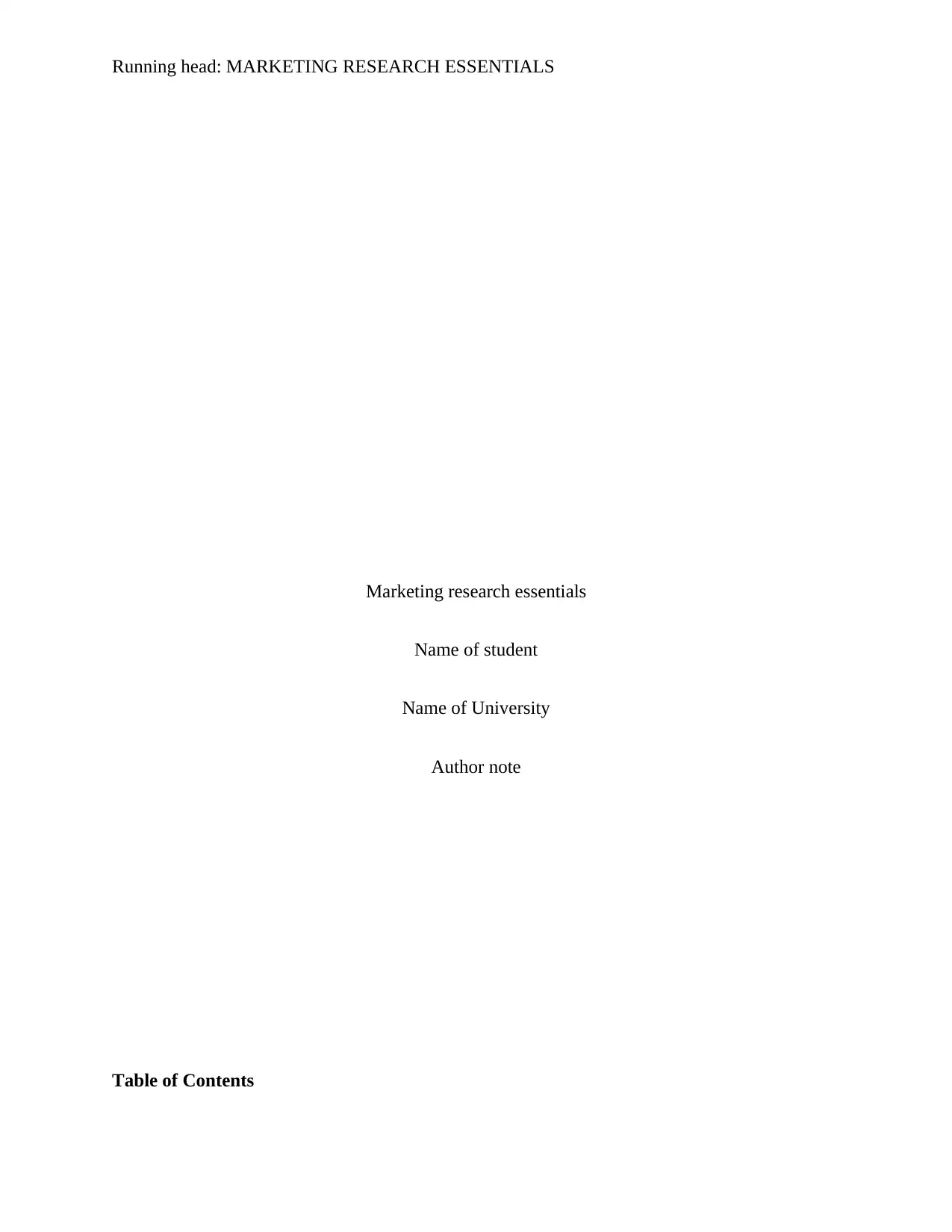
Running head: MARKETING RESEARCH ESSENTIALS
Marketing research essentials
Name of student
Name of University
Author note
Table of Contents
Marketing research essentials
Name of student
Name of University
Author note
Table of Contents
Paraphrase This Document
Need a fresh take? Get an instant paraphrase of this document with our AI Paraphraser
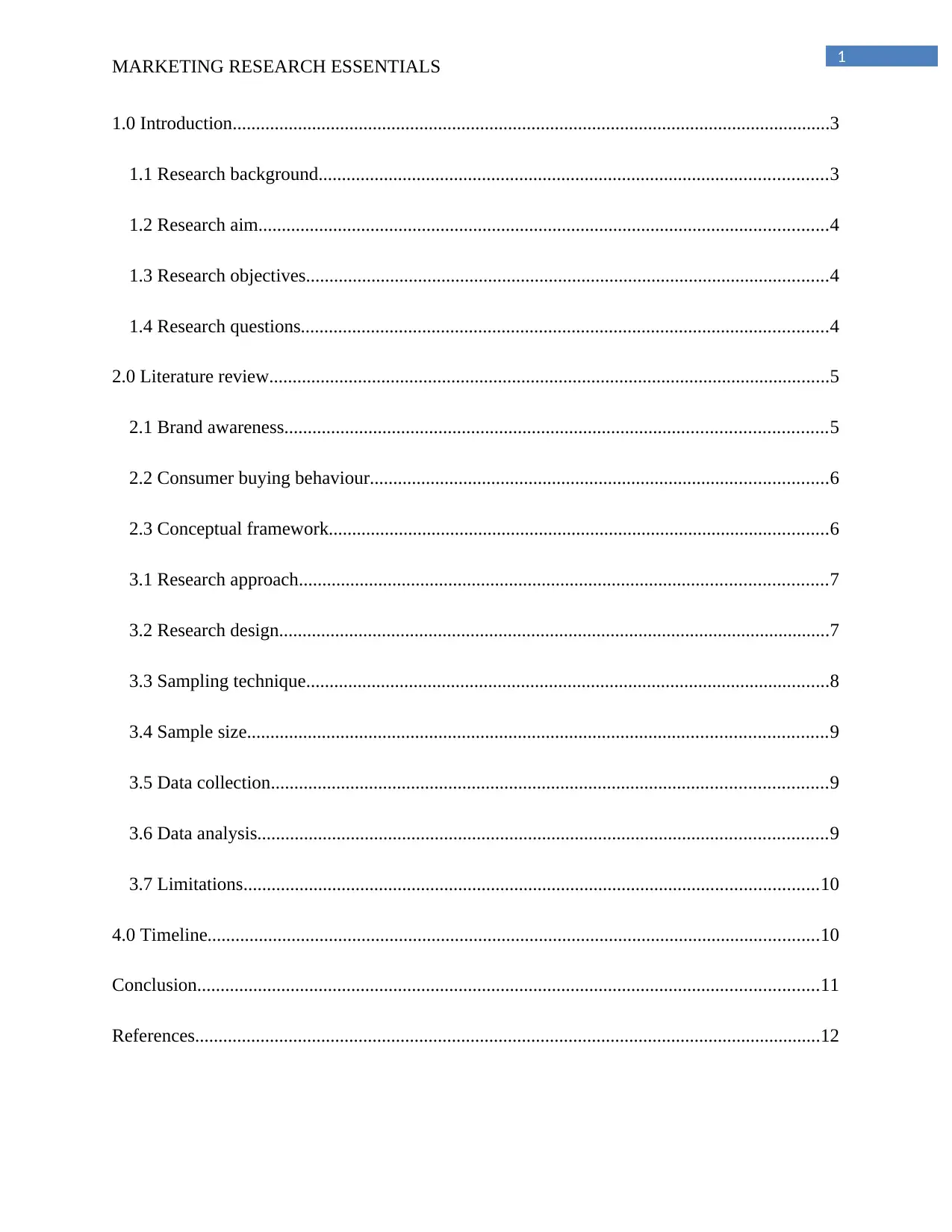
1
MARKETING RESEARCH ESSENTIALS
1.0 Introduction................................................................................................................................3
1.1 Research background.............................................................................................................3
1.2 Research aim..........................................................................................................................4
1.3 Research objectives................................................................................................................4
1.4 Research questions.................................................................................................................4
2.0 Literature review........................................................................................................................5
2.1 Brand awareness....................................................................................................................5
2.2 Consumer buying behaviour..................................................................................................6
2.3 Conceptual framework...........................................................................................................6
3.1 Research approach.................................................................................................................7
3.2 Research design......................................................................................................................7
3.3 Sampling technique................................................................................................................8
3.4 Sample size............................................................................................................................9
3.5 Data collection.......................................................................................................................9
3.6 Data analysis..........................................................................................................................9
3.7 Limitations...........................................................................................................................10
4.0 Timeline...................................................................................................................................10
Conclusion.....................................................................................................................................11
References......................................................................................................................................12
MARKETING RESEARCH ESSENTIALS
1.0 Introduction................................................................................................................................3
1.1 Research background.............................................................................................................3
1.2 Research aim..........................................................................................................................4
1.3 Research objectives................................................................................................................4
1.4 Research questions.................................................................................................................4
2.0 Literature review........................................................................................................................5
2.1 Brand awareness....................................................................................................................5
2.2 Consumer buying behaviour..................................................................................................6
2.3 Conceptual framework...........................................................................................................6
3.1 Research approach.................................................................................................................7
3.2 Research design......................................................................................................................7
3.3 Sampling technique................................................................................................................8
3.4 Sample size............................................................................................................................9
3.5 Data collection.......................................................................................................................9
3.6 Data analysis..........................................................................................................................9
3.7 Limitations...........................................................................................................................10
4.0 Timeline...................................................................................................................................10
Conclusion.....................................................................................................................................11
References......................................................................................................................................12
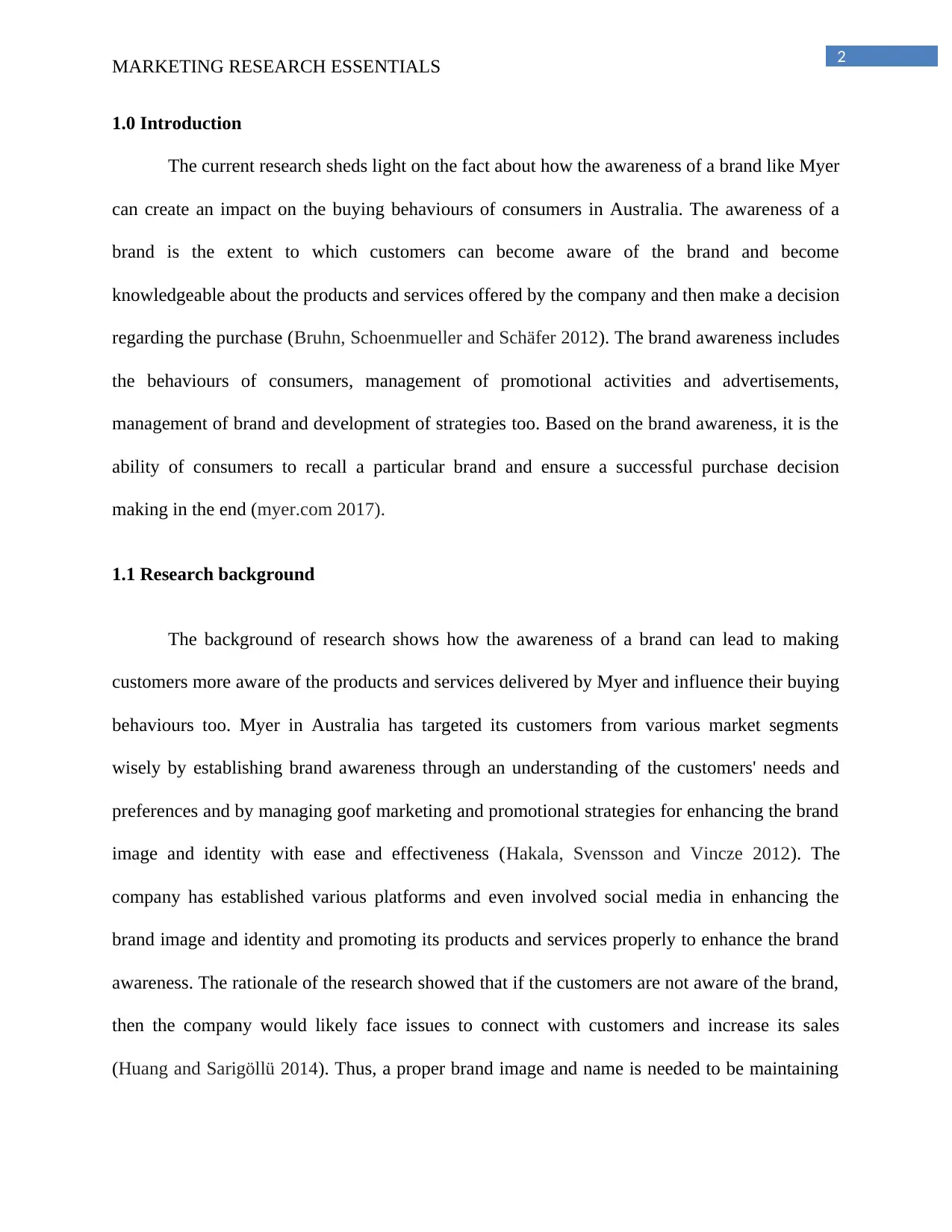
2
MARKETING RESEARCH ESSENTIALS
1.0 Introduction
The current research sheds light on the fact about how the awareness of a brand like Myer
can create an impact on the buying behaviours of consumers in Australia. The awareness of a
brand is the extent to which customers can become aware of the brand and become
knowledgeable about the products and services offered by the company and then make a decision
regarding the purchase (Bruhn, Schoenmueller and Schäfer 2012). The brand awareness includes
the behaviours of consumers, management of promotional activities and advertisements,
management of brand and development of strategies too. Based on the brand awareness, it is the
ability of consumers to recall a particular brand and ensure a successful purchase decision
making in the end (myer.com 2017).
1.1 Research background
The background of research shows how the awareness of a brand can lead to making
customers more aware of the products and services delivered by Myer and influence their buying
behaviours too. Myer in Australia has targeted its customers from various market segments
wisely by establishing brand awareness through an understanding of the customers' needs and
preferences and by managing goof marketing and promotional strategies for enhancing the brand
image and identity with ease and effectiveness (Hakala, Svensson and Vincze 2012). The
company has established various platforms and even involved social media in enhancing the
brand image and identity and promoting its products and services properly to enhance the brand
awareness. The rationale of the research showed that if the customers are not aware of the brand,
then the company would likely face issues to connect with customers and increase its sales
(Huang and Sarigöllü 2014). Thus, a proper brand image and name is needed to be maintaining
MARKETING RESEARCH ESSENTIALS
1.0 Introduction
The current research sheds light on the fact about how the awareness of a brand like Myer
can create an impact on the buying behaviours of consumers in Australia. The awareness of a
brand is the extent to which customers can become aware of the brand and become
knowledgeable about the products and services offered by the company and then make a decision
regarding the purchase (Bruhn, Schoenmueller and Schäfer 2012). The brand awareness includes
the behaviours of consumers, management of promotional activities and advertisements,
management of brand and development of strategies too. Based on the brand awareness, it is the
ability of consumers to recall a particular brand and ensure a successful purchase decision
making in the end (myer.com 2017).
1.1 Research background
The background of research shows how the awareness of a brand can lead to making
customers more aware of the products and services delivered by Myer and influence their buying
behaviours too. Myer in Australia has targeted its customers from various market segments
wisely by establishing brand awareness through an understanding of the customers' needs and
preferences and by managing goof marketing and promotional strategies for enhancing the brand
image and identity with ease and effectiveness (Hakala, Svensson and Vincze 2012). The
company has established various platforms and even involved social media in enhancing the
brand image and identity and promoting its products and services properly to enhance the brand
awareness. The rationale of the research showed that if the customers are not aware of the brand,
then the company would likely face issues to connect with customers and increase its sales
(Huang and Sarigöllü 2014). Thus, a proper brand image and name is needed to be maintaining
⊘ This is a preview!⊘
Do you want full access?
Subscribe today to unlock all pages.

Trusted by 1+ million students worldwide

3
MARKETING RESEARCH ESSENTIALS
for enhancing brand awareness and influence the buying behaviours of consumers (myer.com
2017).
1.2 Research aim
The aim of the research is to assess the impact created by brand awareness on the
purchasing behaviours of consumers considering the business organisation Myer in Australia
(Hutter et al. 2013).
1.3 Research objectives
To identify the impact of brand awareness on the buying behaviours of consumers
To evaluate the various approaches to enhance the brand image and identity of Myer
among the customers
To assess the impact created by a positive brand image on the ability of consumer to
make purchase decisions
To recommend various measures for enhancing the efficiency of brand awareness and
generate more profit through increase in sales of Myer
1.4 Research questions
What is the impact of Myer's brand awareness on the consumer buying behaviour?
How could the various approaches were undertaken by Myer enhance brand awareness?
What could be the probable impact of a positive brand image on the consumer buying
behaviour?
MARKETING RESEARCH ESSENTIALS
for enhancing brand awareness and influence the buying behaviours of consumers (myer.com
2017).
1.2 Research aim
The aim of the research is to assess the impact created by brand awareness on the
purchasing behaviours of consumers considering the business organisation Myer in Australia
(Hutter et al. 2013).
1.3 Research objectives
To identify the impact of brand awareness on the buying behaviours of consumers
To evaluate the various approaches to enhance the brand image and identity of Myer
among the customers
To assess the impact created by a positive brand image on the ability of consumer to
make purchase decisions
To recommend various measures for enhancing the efficiency of brand awareness and
generate more profit through increase in sales of Myer
1.4 Research questions
What is the impact of Myer's brand awareness on the consumer buying behaviour?
How could the various approaches were undertaken by Myer enhance brand awareness?
What could be the probable impact of a positive brand image on the consumer buying
behaviour?
Paraphrase This Document
Need a fresh take? Get an instant paraphrase of this document with our AI Paraphraser
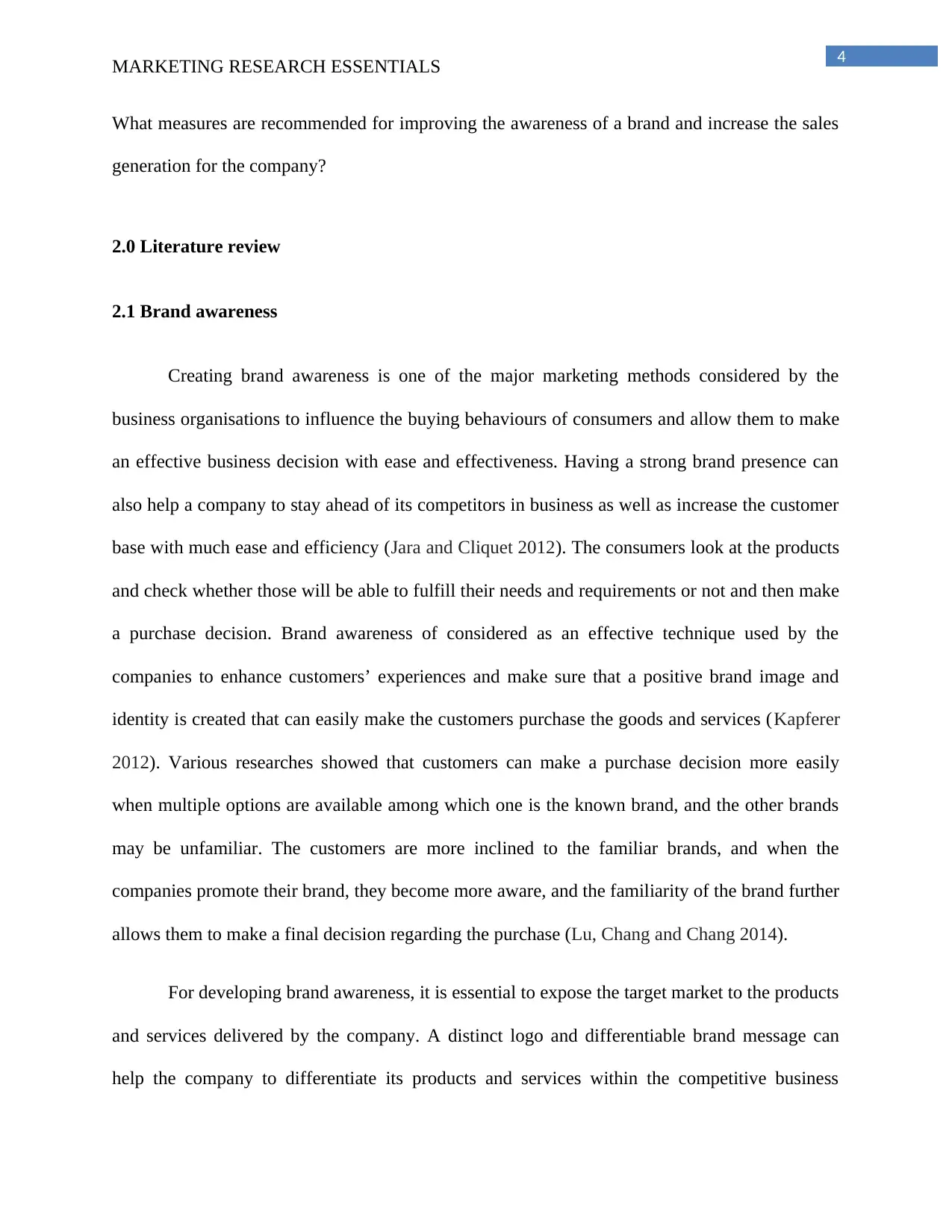
4
MARKETING RESEARCH ESSENTIALS
What measures are recommended for improving the awareness of a brand and increase the sales
generation for the company?
2.0 Literature review
2.1 Brand awareness
Creating brand awareness is one of the major marketing methods considered by the
business organisations to influence the buying behaviours of consumers and allow them to make
an effective business decision with ease and effectiveness. Having a strong brand presence can
also help a company to stay ahead of its competitors in business as well as increase the customer
base with much ease and efficiency (Jara and Cliquet 2012). The consumers look at the products
and check whether those will be able to fulfill their needs and requirements or not and then make
a purchase decision. Brand awareness of considered as an effective technique used by the
companies to enhance customers’ experiences and make sure that a positive brand image and
identity is created that can easily make the customers purchase the goods and services (Kapferer
2012). Various researches showed that customers can make a purchase decision more easily
when multiple options are available among which one is the known brand, and the other brands
may be unfamiliar. The customers are more inclined to the familiar brands, and when the
companies promote their brand, they become more aware, and the familiarity of the brand further
allows them to make a final decision regarding the purchase (Lu, Chang and Chang 2014).
For developing brand awareness, it is essential to expose the target market to the products
and services delivered by the company. A distinct logo and differentiable brand message can
help the company to differentiate its products and services within the competitive business
MARKETING RESEARCH ESSENTIALS
What measures are recommended for improving the awareness of a brand and increase the sales
generation for the company?
2.0 Literature review
2.1 Brand awareness
Creating brand awareness is one of the major marketing methods considered by the
business organisations to influence the buying behaviours of consumers and allow them to make
an effective business decision with ease and effectiveness. Having a strong brand presence can
also help a company to stay ahead of its competitors in business as well as increase the customer
base with much ease and efficiency (Jara and Cliquet 2012). The consumers look at the products
and check whether those will be able to fulfill their needs and requirements or not and then make
a purchase decision. Brand awareness of considered as an effective technique used by the
companies to enhance customers’ experiences and make sure that a positive brand image and
identity is created that can easily make the customers purchase the goods and services (Kapferer
2012). Various researches showed that customers can make a purchase decision more easily
when multiple options are available among which one is the known brand, and the other brands
may be unfamiliar. The customers are more inclined to the familiar brands, and when the
companies promote their brand, they become more aware, and the familiarity of the brand further
allows them to make a final decision regarding the purchase (Lu, Chang and Chang 2014).
For developing brand awareness, it is essential to expose the target market to the products
and services delivered by the company. A distinct logo and differentiable brand message can
help the company to differentiate its products and services within the competitive business
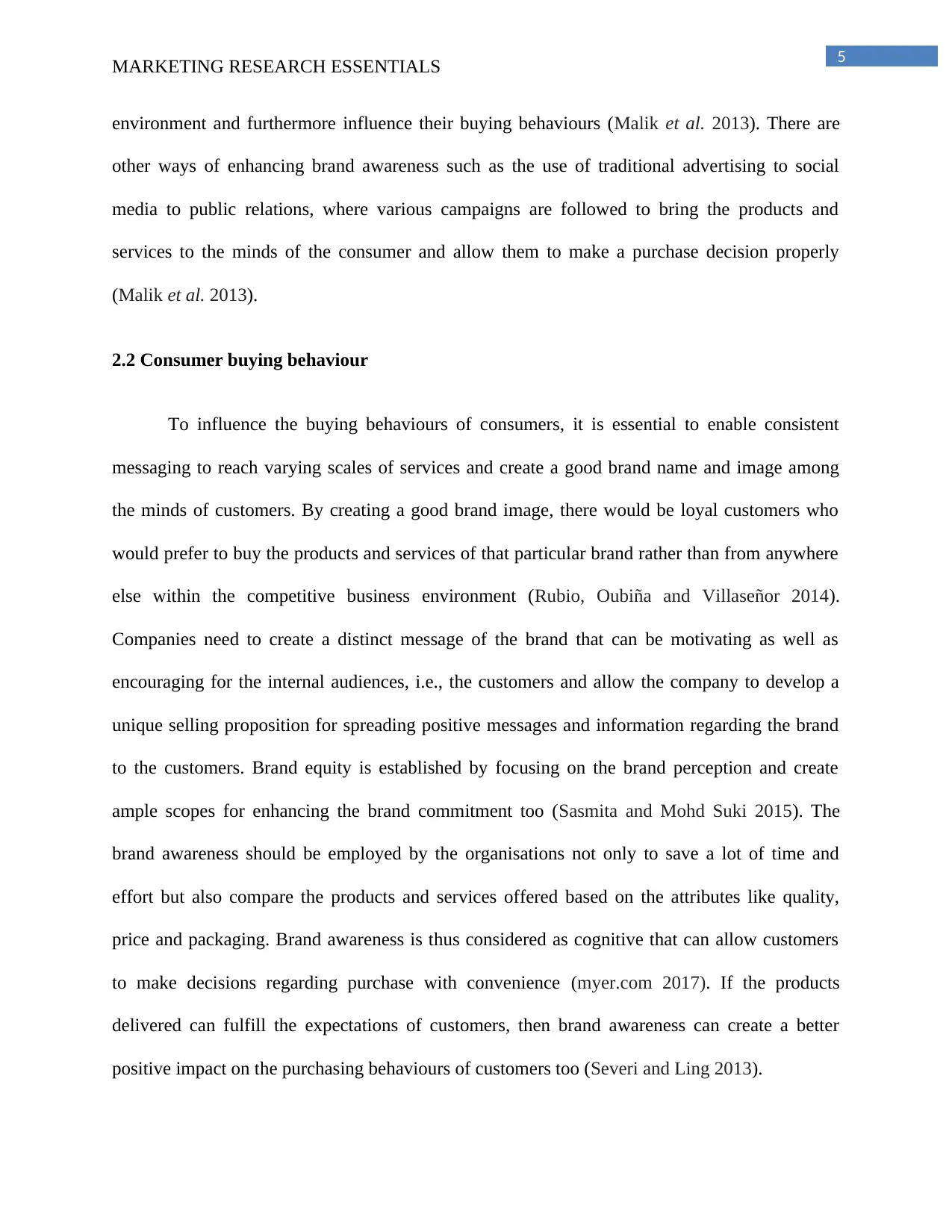
5
MARKETING RESEARCH ESSENTIALS
environment and furthermore influence their buying behaviours (Malik et al. 2013). There are
other ways of enhancing brand awareness such as the use of traditional advertising to social
media to public relations, where various campaigns are followed to bring the products and
services to the minds of the consumer and allow them to make a purchase decision properly
(Malik et al. 2013).
2.2 Consumer buying behaviour
To influence the buying behaviours of consumers, it is essential to enable consistent
messaging to reach varying scales of services and create a good brand name and image among
the minds of customers. By creating a good brand image, there would be loyal customers who
would prefer to buy the products and services of that particular brand rather than from anywhere
else within the competitive business environment (Rubio, Oubiña and Villaseñor 2014).
Companies need to create a distinct message of the brand that can be motivating as well as
encouraging for the internal audiences, i.e., the customers and allow the company to develop a
unique selling proposition for spreading positive messages and information regarding the brand
to the customers. Brand equity is established by focusing on the brand perception and create
ample scopes for enhancing the brand commitment too (Sasmita and Mohd Suki 2015). The
brand awareness should be employed by the organisations not only to save a lot of time and
effort but also compare the products and services offered based on the attributes like quality,
price and packaging. Brand awareness is thus considered as cognitive that can allow customers
to make decisions regarding purchase with convenience (myer.com 2017). If the products
delivered can fulfill the expectations of customers, then brand awareness can create a better
positive impact on the purchasing behaviours of customers too (Severi and Ling 2013).
MARKETING RESEARCH ESSENTIALS
environment and furthermore influence their buying behaviours (Malik et al. 2013). There are
other ways of enhancing brand awareness such as the use of traditional advertising to social
media to public relations, where various campaigns are followed to bring the products and
services to the minds of the consumer and allow them to make a purchase decision properly
(Malik et al. 2013).
2.2 Consumer buying behaviour
To influence the buying behaviours of consumers, it is essential to enable consistent
messaging to reach varying scales of services and create a good brand name and image among
the minds of customers. By creating a good brand image, there would be loyal customers who
would prefer to buy the products and services of that particular brand rather than from anywhere
else within the competitive business environment (Rubio, Oubiña and Villaseñor 2014).
Companies need to create a distinct message of the brand that can be motivating as well as
encouraging for the internal audiences, i.e., the customers and allow the company to develop a
unique selling proposition for spreading positive messages and information regarding the brand
to the customers. Brand equity is established by focusing on the brand perception and create
ample scopes for enhancing the brand commitment too (Sasmita and Mohd Suki 2015). The
brand awareness should be employed by the organisations not only to save a lot of time and
effort but also compare the products and services offered based on the attributes like quality,
price and packaging. Brand awareness is thus considered as cognitive that can allow customers
to make decisions regarding purchase with convenience (myer.com 2017). If the products
delivered can fulfill the expectations of customers, then brand awareness can create a better
positive impact on the purchasing behaviours of customers too (Severi and Ling 2013).
⊘ This is a preview!⊘
Do you want full access?
Subscribe today to unlock all pages.

Trusted by 1+ million students worldwide
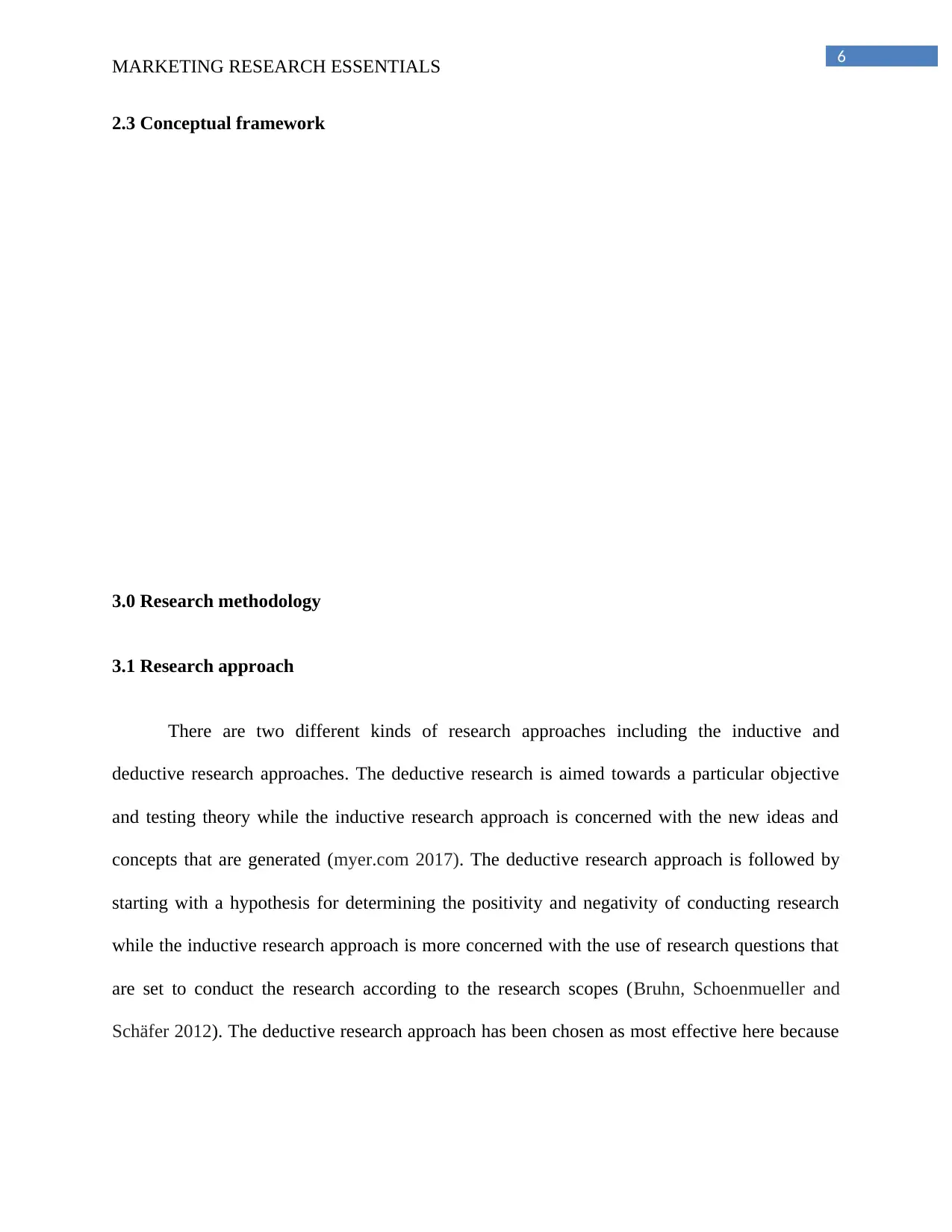
6
MARKETING RESEARCH ESSENTIALS
2.3 Conceptual framework
3.0 Research methodology
3.1 Research approach
There are two different kinds of research approaches including the inductive and
deductive research approaches. The deductive research is aimed towards a particular objective
and testing theory while the inductive research approach is concerned with the new ideas and
concepts that are generated (myer.com 2017). The deductive research approach is followed by
starting with a hypothesis for determining the positivity and negativity of conducting research
while the inductive research approach is more concerned with the use of research questions that
are set to conduct the research according to the research scopes (Bruhn, Schoenmueller and
Schäfer 2012). The deductive research approach has been chosen as most effective here because
MARKETING RESEARCH ESSENTIALS
2.3 Conceptual framework
3.0 Research methodology
3.1 Research approach
There are two different kinds of research approaches including the inductive and
deductive research approaches. The deductive research is aimed towards a particular objective
and testing theory while the inductive research approach is concerned with the new ideas and
concepts that are generated (myer.com 2017). The deductive research approach is followed by
starting with a hypothesis for determining the positivity and negativity of conducting research
while the inductive research approach is more concerned with the use of research questions that
are set to conduct the research according to the research scopes (Bruhn, Schoenmueller and
Schäfer 2012). The deductive research approach has been chosen as most effective here because
Paraphrase This Document
Need a fresh take? Get an instant paraphrase of this document with our AI Paraphraser
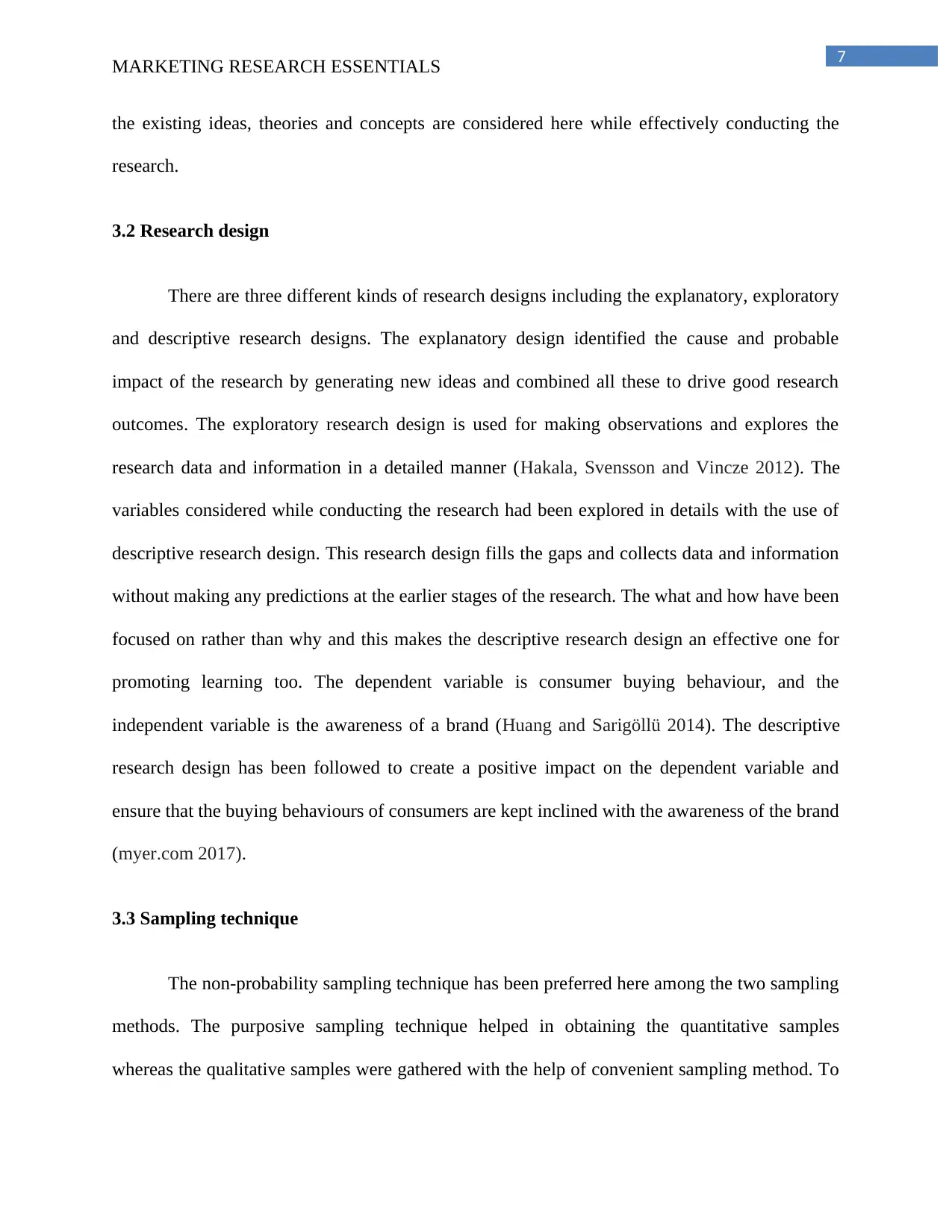
7
MARKETING RESEARCH ESSENTIALS
the existing ideas, theories and concepts are considered here while effectively conducting the
research.
3.2 Research design
There are three different kinds of research designs including the explanatory, exploratory
and descriptive research designs. The explanatory design identified the cause and probable
impact of the research by generating new ideas and combined all these to drive good research
outcomes. The exploratory research design is used for making observations and explores the
research data and information in a detailed manner (Hakala, Svensson and Vincze 2012). The
variables considered while conducting the research had been explored in details with the use of
descriptive research design. This research design fills the gaps and collects data and information
without making any predictions at the earlier stages of the research. The what and how have been
focused on rather than why and this makes the descriptive research design an effective one for
promoting learning too. The dependent variable is consumer buying behaviour, and the
independent variable is the awareness of a brand (Huang and Sarigöllü 2014). The descriptive
research design has been followed to create a positive impact on the dependent variable and
ensure that the buying behaviours of consumers are kept inclined with the awareness of the brand
(myer.com 2017).
3.3 Sampling technique
The non-probability sampling technique has been preferred here among the two sampling
methods. The purposive sampling technique helped in obtaining the quantitative samples
whereas the qualitative samples were gathered with the help of convenient sampling method. To
MARKETING RESEARCH ESSENTIALS
the existing ideas, theories and concepts are considered here while effectively conducting the
research.
3.2 Research design
There are three different kinds of research designs including the explanatory, exploratory
and descriptive research designs. The explanatory design identified the cause and probable
impact of the research by generating new ideas and combined all these to drive good research
outcomes. The exploratory research design is used for making observations and explores the
research data and information in a detailed manner (Hakala, Svensson and Vincze 2012). The
variables considered while conducting the research had been explored in details with the use of
descriptive research design. This research design fills the gaps and collects data and information
without making any predictions at the earlier stages of the research. The what and how have been
focused on rather than why and this makes the descriptive research design an effective one for
promoting learning too. The dependent variable is consumer buying behaviour, and the
independent variable is the awareness of a brand (Huang and Sarigöllü 2014). The descriptive
research design has been followed to create a positive impact on the dependent variable and
ensure that the buying behaviours of consumers are kept inclined with the awareness of the brand
(myer.com 2017).
3.3 Sampling technique
The non-probability sampling technique has been preferred here among the two sampling
methods. The purposive sampling technique helped in obtaining the quantitative samples
whereas the qualitative samples were gathered with the help of convenient sampling method. To
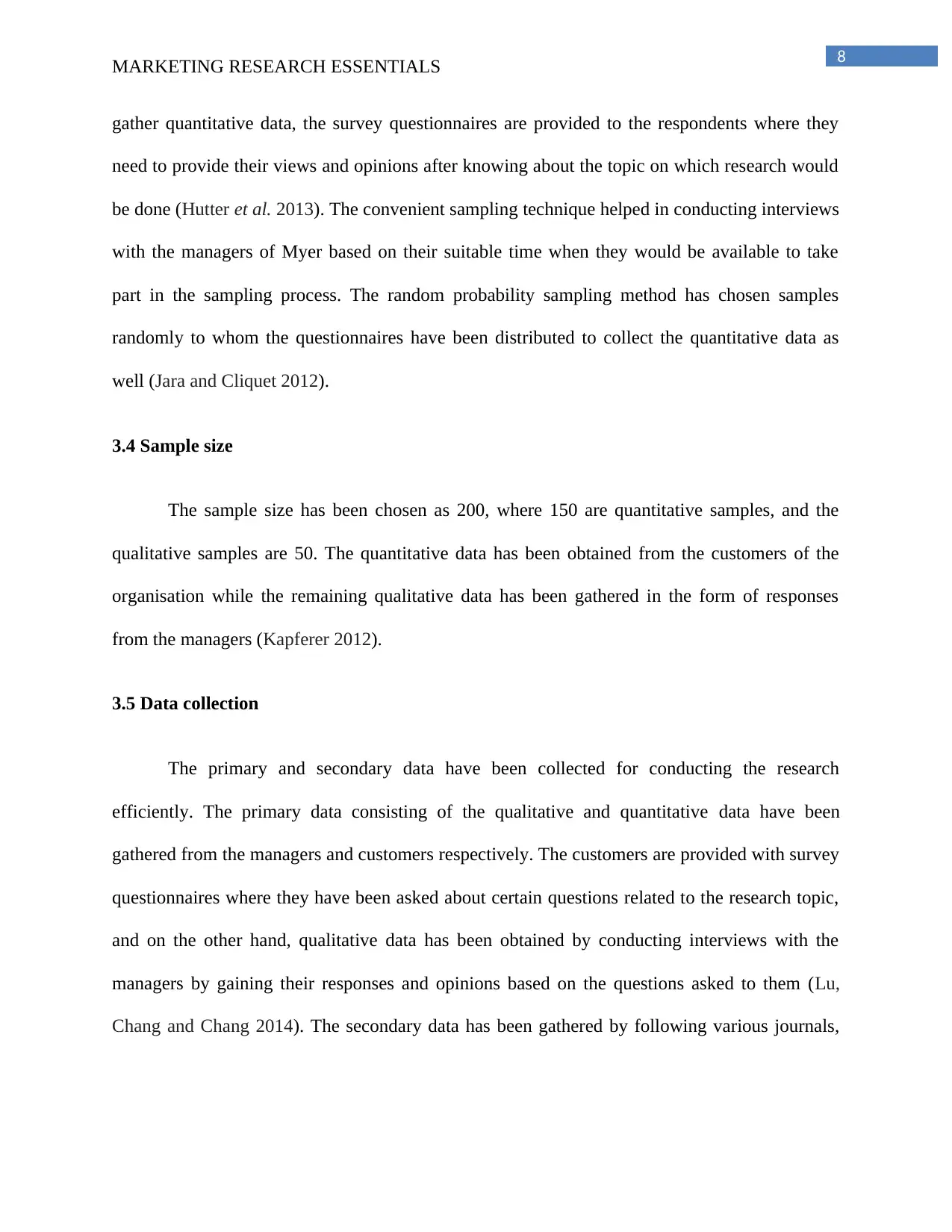
8
MARKETING RESEARCH ESSENTIALS
gather quantitative data, the survey questionnaires are provided to the respondents where they
need to provide their views and opinions after knowing about the topic on which research would
be done (Hutter et al. 2013). The convenient sampling technique helped in conducting interviews
with the managers of Myer based on their suitable time when they would be available to take
part in the sampling process. The random probability sampling method has chosen samples
randomly to whom the questionnaires have been distributed to collect the quantitative data as
well (Jara and Cliquet 2012).
3.4 Sample size
The sample size has been chosen as 200, where 150 are quantitative samples, and the
qualitative samples are 50. The quantitative data has been obtained from the customers of the
organisation while the remaining qualitative data has been gathered in the form of responses
from the managers (Kapferer 2012).
3.5 Data collection
The primary and secondary data have been collected for conducting the research
efficiently. The primary data consisting of the qualitative and quantitative data have been
gathered from the managers and customers respectively. The customers are provided with survey
questionnaires where they have been asked about certain questions related to the research topic,
and on the other hand, qualitative data has been obtained by conducting interviews with the
managers by gaining their responses and opinions based on the questions asked to them (Lu,
Chang and Chang 2014). The secondary data has been gathered by following various journals,
MARKETING RESEARCH ESSENTIALS
gather quantitative data, the survey questionnaires are provided to the respondents where they
need to provide their views and opinions after knowing about the topic on which research would
be done (Hutter et al. 2013). The convenient sampling technique helped in conducting interviews
with the managers of Myer based on their suitable time when they would be available to take
part in the sampling process. The random probability sampling method has chosen samples
randomly to whom the questionnaires have been distributed to collect the quantitative data as
well (Jara and Cliquet 2012).
3.4 Sample size
The sample size has been chosen as 200, where 150 are quantitative samples, and the
qualitative samples are 50. The quantitative data has been obtained from the customers of the
organisation while the remaining qualitative data has been gathered in the form of responses
from the managers (Kapferer 2012).
3.5 Data collection
The primary and secondary data have been collected for conducting the research
efficiently. The primary data consisting of the qualitative and quantitative data have been
gathered from the managers and customers respectively. The customers are provided with survey
questionnaires where they have been asked about certain questions related to the research topic,
and on the other hand, qualitative data has been obtained by conducting interviews with the
managers by gaining their responses and opinions based on the questions asked to them (Lu,
Chang and Chang 2014). The secondary data has been gathered by following various journals,
⊘ This is a preview!⊘
Do you want full access?
Subscribe today to unlock all pages.

Trusted by 1+ million students worldwide
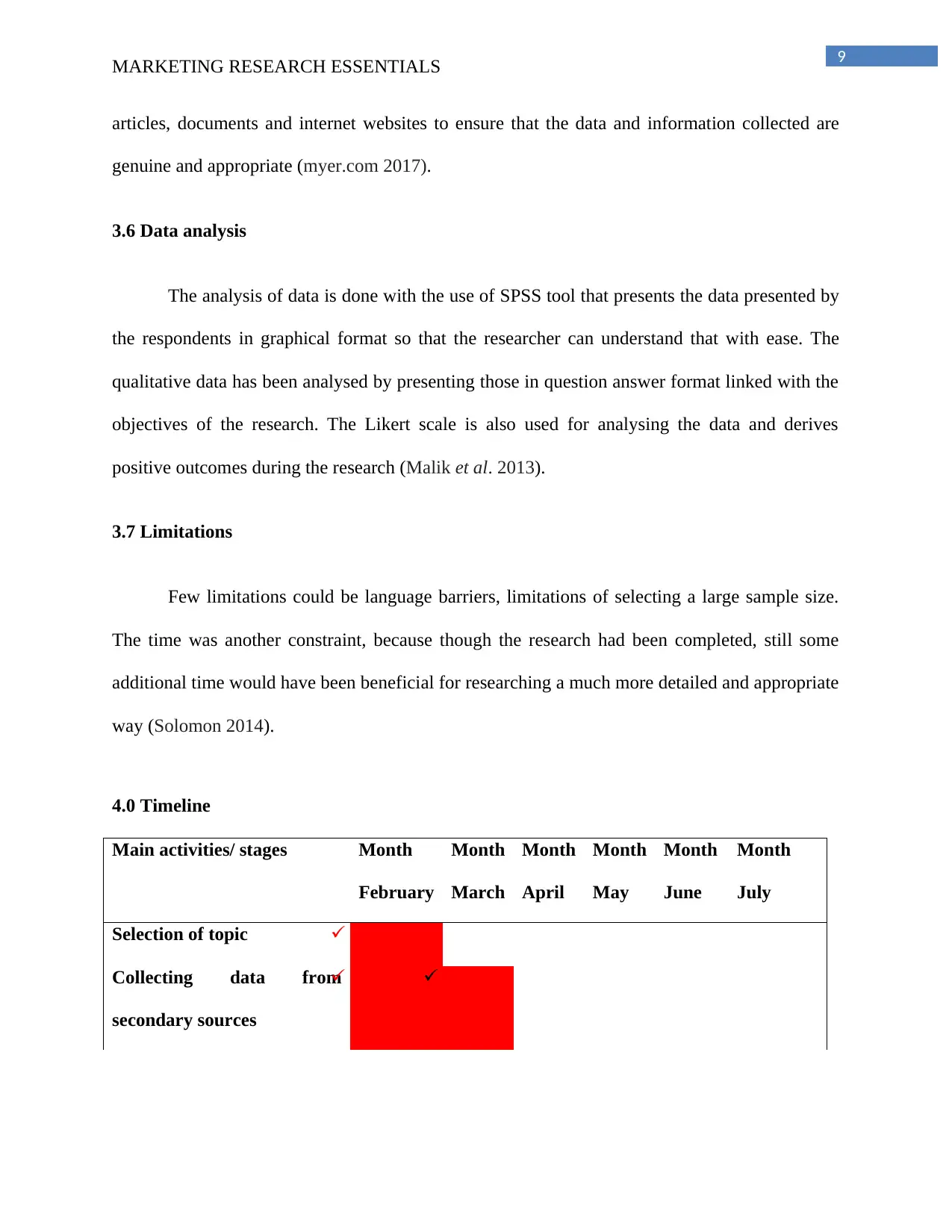
9
MARKETING RESEARCH ESSENTIALS
articles, documents and internet websites to ensure that the data and information collected are
genuine and appropriate (myer.com 2017).
3.6 Data analysis
The analysis of data is done with the use of SPSS tool that presents the data presented by
the respondents in graphical format so that the researcher can understand that with ease. The
qualitative data has been analysed by presenting those in question answer format linked with the
objectives of the research. The Likert scale is also used for analysing the data and derives
positive outcomes during the research (Malik et al. 2013).
3.7 Limitations
Few limitations could be language barriers, limitations of selecting a large sample size.
The time was another constraint, because though the research had been completed, still some
additional time would have been beneficial for researching a much more detailed and appropriate
way (Solomon 2014).
4.0 Timeline
Main activities/ stages Month
February
Month
March
Month
April
Month
May
Month
June
Month
July
Selection of topic
Collecting data from
secondary sources
MARKETING RESEARCH ESSENTIALS
articles, documents and internet websites to ensure that the data and information collected are
genuine and appropriate (myer.com 2017).
3.6 Data analysis
The analysis of data is done with the use of SPSS tool that presents the data presented by
the respondents in graphical format so that the researcher can understand that with ease. The
qualitative data has been analysed by presenting those in question answer format linked with the
objectives of the research. The Likert scale is also used for analysing the data and derives
positive outcomes during the research (Malik et al. 2013).
3.7 Limitations
Few limitations could be language barriers, limitations of selecting a large sample size.
The time was another constraint, because though the research had been completed, still some
additional time would have been beneficial for researching a much more detailed and appropriate
way (Solomon 2014).
4.0 Timeline
Main activities/ stages Month
February
Month
March
Month
April
Month
May
Month
June
Month
July
Selection of topic
Collecting data from
secondary sources
Paraphrase This Document
Need a fresh take? Get an instant paraphrase of this document with our AI Paraphraser
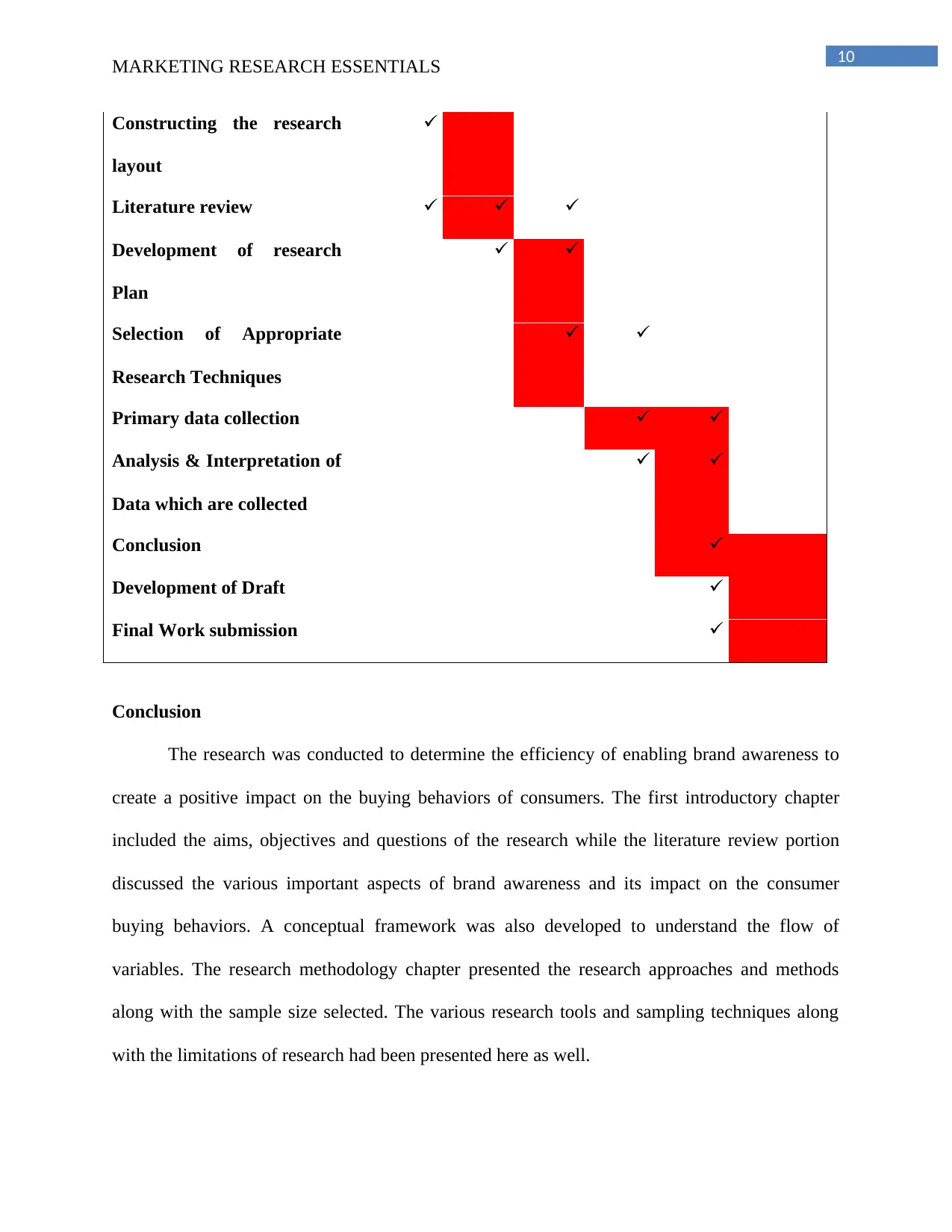
10
MARKETING RESEARCH ESSENTIALS
Constructing the research
layout
Literature review
Development of research
Plan
Selection of Appropriate
Research Techniques
Primary data collection
Analysis & Interpretation of
Data which are collected
Conclusion
Development of Draft
Final Work submission
Conclusion
The research was conducted to determine the efficiency of enabling brand awareness to
create a positive impact on the buying behaviors of consumers. The first introductory chapter
included the aims, objectives and questions of the research while the literature review portion
discussed the various important aspects of brand awareness and its impact on the consumer
buying behaviors. A conceptual framework was also developed to understand the flow of
variables. The research methodology chapter presented the research approaches and methods
along with the sample size selected. The various research tools and sampling techniques along
with the limitations of research had been presented here as well.
MARKETING RESEARCH ESSENTIALS
Constructing the research
layout
Literature review
Development of research
Plan
Selection of Appropriate
Research Techniques
Primary data collection
Analysis & Interpretation of
Data which are collected
Conclusion
Development of Draft
Final Work submission
Conclusion
The research was conducted to determine the efficiency of enabling brand awareness to
create a positive impact on the buying behaviors of consumers. The first introductory chapter
included the aims, objectives and questions of the research while the literature review portion
discussed the various important aspects of brand awareness and its impact on the consumer
buying behaviors. A conceptual framework was also developed to understand the flow of
variables. The research methodology chapter presented the research approaches and methods
along with the sample size selected. The various research tools and sampling techniques along
with the limitations of research had been presented here as well.
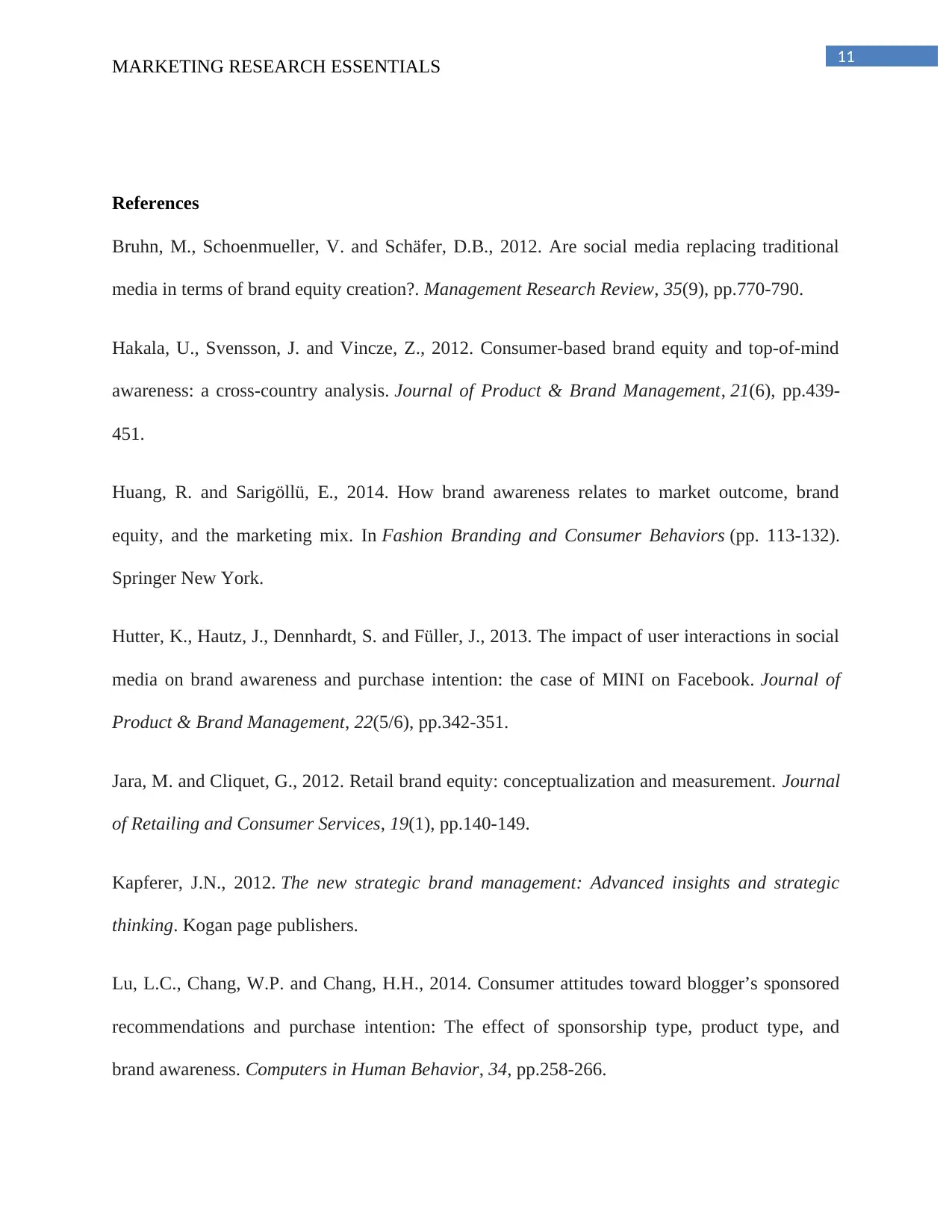
11
MARKETING RESEARCH ESSENTIALS
References
Bruhn, M., Schoenmueller, V. and Schäfer, D.B., 2012. Are social media replacing traditional
media in terms of brand equity creation?. Management Research Review, 35(9), pp.770-790.
Hakala, U., Svensson, J. and Vincze, Z., 2012. Consumer-based brand equity and top-of-mind
awareness: a cross-country analysis. Journal of Product & Brand Management, 21(6), pp.439-
451.
Huang, R. and Sarigöllü, E., 2014. How brand awareness relates to market outcome, brand
equity, and the marketing mix. In Fashion Branding and Consumer Behaviors (pp. 113-132).
Springer New York.
Hutter, K., Hautz, J., Dennhardt, S. and Füller, J., 2013. The impact of user interactions in social
media on brand awareness and purchase intention: the case of MINI on Facebook. Journal of
Product & Brand Management, 22(5/6), pp.342-351.
Jara, M. and Cliquet, G., 2012. Retail brand equity: conceptualization and measurement. Journal
of Retailing and Consumer Services, 19(1), pp.140-149.
Kapferer, J.N., 2012. The new strategic brand management: Advanced insights and strategic
thinking. Kogan page publishers.
Lu, L.C., Chang, W.P. and Chang, H.H., 2014. Consumer attitudes toward blogger’s sponsored
recommendations and purchase intention: The effect of sponsorship type, product type, and
brand awareness. Computers in Human Behavior, 34, pp.258-266.
MARKETING RESEARCH ESSENTIALS
References
Bruhn, M., Schoenmueller, V. and Schäfer, D.B., 2012. Are social media replacing traditional
media in terms of brand equity creation?. Management Research Review, 35(9), pp.770-790.
Hakala, U., Svensson, J. and Vincze, Z., 2012. Consumer-based brand equity and top-of-mind
awareness: a cross-country analysis. Journal of Product & Brand Management, 21(6), pp.439-
451.
Huang, R. and Sarigöllü, E., 2014. How brand awareness relates to market outcome, brand
equity, and the marketing mix. In Fashion Branding and Consumer Behaviors (pp. 113-132).
Springer New York.
Hutter, K., Hautz, J., Dennhardt, S. and Füller, J., 2013. The impact of user interactions in social
media on brand awareness and purchase intention: the case of MINI on Facebook. Journal of
Product & Brand Management, 22(5/6), pp.342-351.
Jara, M. and Cliquet, G., 2012. Retail brand equity: conceptualization and measurement. Journal
of Retailing and Consumer Services, 19(1), pp.140-149.
Kapferer, J.N., 2012. The new strategic brand management: Advanced insights and strategic
thinking. Kogan page publishers.
Lu, L.C., Chang, W.P. and Chang, H.H., 2014. Consumer attitudes toward blogger’s sponsored
recommendations and purchase intention: The effect of sponsorship type, product type, and
brand awareness. Computers in Human Behavior, 34, pp.258-266.
⊘ This is a preview!⊘
Do you want full access?
Subscribe today to unlock all pages.

Trusted by 1+ million students worldwide
1 out of 13
Related Documents
Your All-in-One AI-Powered Toolkit for Academic Success.
+13062052269
info@desklib.com
Available 24*7 on WhatsApp / Email
![[object Object]](/_next/static/media/star-bottom.7253800d.svg)
Unlock your academic potential
Copyright © 2020–2025 A2Z Services. All Rights Reserved. Developed and managed by ZUCOL.





